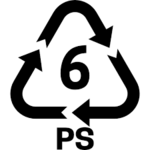PS (6): Difference between revisions
mNo edit summary |
No edit summary |
||
| Line 7: | Line 7: | ||
[[PS (6)]] plastic is a naturally occuring transparent thermoplastic that is available as both a typical solid plastic as well as a rigid foam material (Expanded Polystyrene). PS plastic is commonly used in a variety of consumer product applications and in commercial packaging<ref name="CRE">[https://www.creativemechanisms.com/blog/polystyrene-ps-plastic/ Creative Mechanisms]</ref>. Dow Chemcial Company invented a proprietary process to make their trademarked and well known polystyrene foam product "styrofoam" (EPS) in 1941<ref name="CRE" />. | [[PS (6)]] plastic is a naturally occuring transparent thermoplastic that is available as both a typical solid plastic as well as a rigid foam material (Expanded Polystyrene). PS plastic is commonly used in a variety of consumer product applications and in commercial packaging<ref name="CRE">[https://www.creativemechanisms.com/blog/polystyrene-ps-plastic/ Creative Mechanisms]</ref>. Dow Chemcial Company invented a proprietary process to make their trademarked and well known polystyrene foam product "styrofoam" (EPS) in 1941<ref name="CRE" />. | ||
The solid plastic form of polystyrene is commonly used in medical device applications like test tubes or petri dishes, or in day-to-day items like the housing on smoke detectors, CDs cases, and frequently as a container for foods like yogurt and individual desserts<ref name="CRE" />. The foam form of polystyrene (EPS) is most often used as a packaging material particulalry in high value items such as televisions, washing machines, dishwashers etc <ref name="CRE" /> where it has been moulded to fit the product it is protecting. Polystyrene beads are tiny bits of expanded polystyrene and are commonly found in bean bags and childrens toys | The solid plastic form of polystyrene is commonly used in medical device applications like test tubes or petri dishes, or in day-to-day items like the housing on smoke detectors, CDs cases, and frequently as a container for foods like yogurt and individual desserts<ref name="CRE" />. The foam form of polystyrene (EPS) is most often used as a packaging material particulalry in high value items such as televisions, washing machines, dishwashers etc <ref name="CRE" /> where it has been moulded to fit the product it is protecting. Polystyrene beads are tiny bits of expanded polystyrene and are commonly found in bean bags and childrens toys such as in stuffed animals/teddy bears and as home insulation. The larger loose form of EPS (in the shape of 'figures of 8') are most commonly used to protect smaller less expansive items although their use is being phased out with more environmentally friendly alternatives (such as brown paper packaging) which can be re-used and recycled more easily. | ||
==References== | ==References== | ||
<references /> | <references /> | ||
Revision as of 12:37, 12 July 2022
PS (Polystyrene) is a type of plastic commonly used in Pots Tubs and Trays (or otherwise known as PTT) and is captured as PS (6) in WikiWaste. Expanded Polystyrene (EPS) can be used as a packaging fill material and is captured in the same category in WikiWaste.

PS (6) plastic is a naturally occuring transparent thermoplastic that is available as both a typical solid plastic as well as a rigid foam material (Expanded Polystyrene). PS plastic is commonly used in a variety of consumer product applications and in commercial packaging[1]. Dow Chemcial Company invented a proprietary process to make their trademarked and well known polystyrene foam product "styrofoam" (EPS) in 1941[1].
The solid plastic form of polystyrene is commonly used in medical device applications like test tubes or petri dishes, or in day-to-day items like the housing on smoke detectors, CDs cases, and frequently as a container for foods like yogurt and individual desserts[1]. The foam form of polystyrene (EPS) is most often used as a packaging material particulalry in high value items such as televisions, washing machines, dishwashers etc [1] where it has been moulded to fit the product it is protecting. Polystyrene beads are tiny bits of expanded polystyrene and are commonly found in bean bags and childrens toys such as in stuffed animals/teddy bears and as home insulation. The larger loose form of EPS (in the shape of 'figures of 8') are most commonly used to protect smaller less expansive items although their use is being phased out with more environmentally friendly alternatives (such as brown paper packaging) which can be re-used and recycled more easily.
